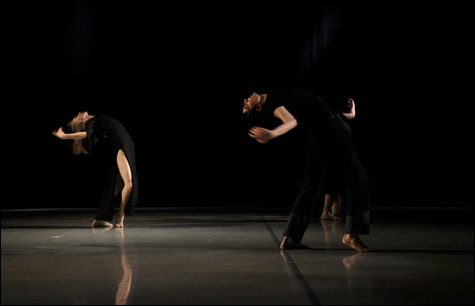
BORROWED BONES: Lush and lyrical, with a clear sense of space and continuity. |
Kelley Donovan's Borrowed Bones at the Dance Complex last weekend featured Donovan and nine accomplices in 40 minutes of intense dancing. The piece transcended the ordinary in a couple of important ways. First of all, Donovan's movement, as attested by three solos studding the piece, is lush and lyrical. Few choreographers today have such a clear sense of space and continuity.
The dancers carve out curves and curlicues with their arms, and their bodies, flexible, ready for change, follow these pathways. Everything — their shoulders, their navels, their eyes — seems equally capable of leading the way through space. Even when they fling out unpredictably, you feel they always know where they're going. Movement can come from any source in the body and continue out in generous whipped spirals or sinuous curves, thrusting drives or rolling falls. Once initiated, the energy seems inexhaustible; any body part can take over and go off in another direction.
These highly articulate bodies are also highly energized. Donovan and the dancers aren't just making shapes, they're moving with a sense of variable momentum. They can begin a phrase with a sudden spurt, then let the energy dribble down to a crawl. They can suspend a gesture with a long, luxurious delay, then drift into something else. They can be striding along, then pitch forward onto one knee, splay out flat, and scramble up again before you see how it happened. The only time the momentum gets broken is when it's unexpectedly impeded by another dancer.
Persons hurl themselves at other persons who sturdily absorb the impact. Or someone will arrest a partner's movement by grabbing him or her in midair. But the lifting and holding can be soft and yielding, too, as one partner scoops up another and continues her momentum. Two women team up to carry a man along with them.
As interesting as Donovan's movement is, it's not entirely preoccupied with individual action. Her other special gift is for composition, the building of patterns in time and space. Her own solos provide material that gets expanded and elaborated on by the other dancers, so you recognize a swing of the arms, an arch of the back, a falling forward, as it recurs, marking the dance's identity. The language resembles the original gestures less as the dance evolves, but it still feels familiar.
Little group interactions begin to coalesce as the dancers come and go. Persons pick other persons up and carry them off unprotesting. A woman dances a solo in counterpoint with a tight group of women who fall into almost accidental synchronization with her. When the solo woman accelerates into a series of turns, the group splinters apart, as if struck by a laser beam. Another group leap in a circle around another solo dancer. All these motifs collect gradually and dissipate almost as soon as you recognize them.
The dancers don't give signs of personal engagement with one another even though their contacts may be intimate — but because of the built-in movement connections, the potential is there. At some point, the music — which, consisting of sounds from various sources, has been puttering along in the background — grows slightly more specific. Voices and a guitar are strumming chords, clearing throats, as if getting ready to start a song. The dancers seem to be finding a beat in this and getting ready to dance to it. Then the preparation stops and the dancers run off, and the lights go out.